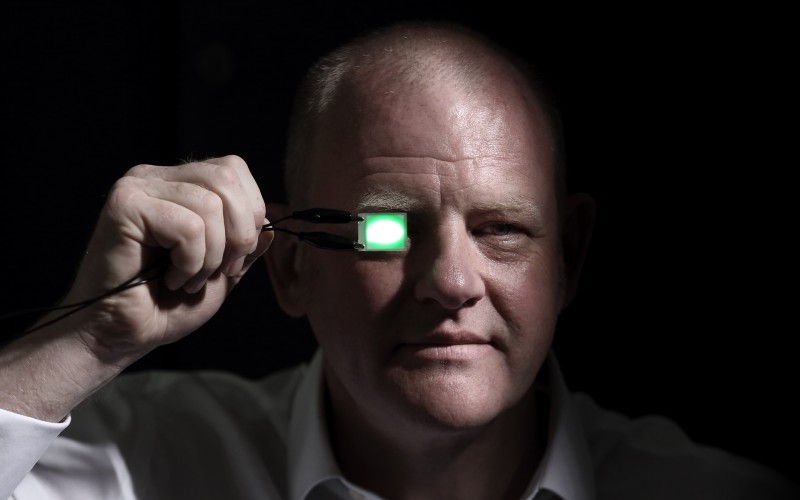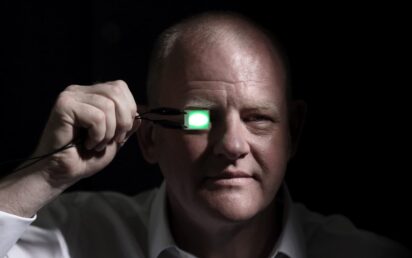If you’re an ambitious startup founder looking to build for the future, Richard Kirk has a golden nugget of advice for you.
The CEO and founder of PolyPhotonix – a Sedgefield-based business behind a sight-saving mask for diabetics – says you should focus on the make-up of your board.
“My first business had lots of dysfunction in it: I had a chairman who was independently wealthy, lived in Spain and didn’t want to come back to board meetings; I had a finance director who was a co-owner and just wanted to retire,” he explains to TechBlast.
“I could only do so much with the business. When I wanted to expand and move it forward, I was prevented by my board. So when I set up this business, I did it in an entirely different way.”
Kirk is our latest Star of the Week for bringing PolyPhotonix’s Noctura 400 sleep mask to market. More than a decade in the making, the technology delivers a precise type of light into the eyes to reduce and reverse the effects of diabetic retinopathy.
The condition is considered the leading cause of preventable blindness among working-age individuals in the Western world. You can read about how the amazing technology – now being used by my own father – works in the story below.
Celebrated artist
Kirk does not fit the typical MedTech entrepreneur background of either medical practice or academia. A former commercial artist who lived in Paris for eight years – one of his ‘grey squares’ creations still hangs above his mantelpiece, while he was collected by the national gallery in France – he experienced an ‘epiphany’ upon returning to London towards the end of the 20th Century.
“I realised that I wasn’t that good a painter! Even though my work was selling and I had good dealers, I wasn’t going to reinvent modernism,” he considers.
“I started looking for something to do and met somebody in a pub in Soho who was involved in an early printed electronics technology called electroluminescence. I thought this was absolutely fabulous.
“I went off to see some people involved in this technology and set my first business up from a standing start to become the largest printed electronics company in Europe, with several world firsts.”
JCDecaux
Elumin8 laid down extremely thin layers of inorganic materials in stacks which, when a current was run through, interacted with each other to produce light. In the days before LEDs, the firm provided huge animated posters for out-of-home advertising giant JCDecaux in 25 countries.
“It turns out that I could have been a physicist as I understand material science,” says Kirk, who also studied fine art at university in the 80s.
“[In 2008] I set up PolyPhotonix in partnership with the Centre for Process Innovation, a centre of excellence in Tony Blair’s former constituency in Sedgefield which had a lot of money channelled into it.
“The first difference with my former business is that I had a big public sector partner and shareholder in the CPI. I then made a board of some quite impressive people because I didn’t want to end up in the same situation – controlled by a couple of individuals that lacked vision.”
Partnering with the CPI enabled PolyPhotonix – which laid down layers of material in microns amounting to 1,000 times thinner than a human hair – to build a facility of clean rooms and processing equipment which cost in the tens of millions of pounds.
Kissing frogs
Having built a highly skilled team of light scientists – “at one point, everybody in the business had a PhD except myself and my number two!” – he then began to look for a business focus.
“The long-term challenge was the giant companies in Asia such as LG and Samsung are involved in this area as well – and they have pockets far deeper than anything in Europe. So I began to look at practical applications for the technology,” he says.
“I describe that process as kissing frogs. If you kiss enough frogs, one of them will come good. It’s just a question of kissing enough of them!”
The medical arena was attractive as a high value-add so he attended conferences until he found himself listening to a gentleman explaining the theory behind ‘dark adaptation’ of the eye and how this can lead to blindness in diabetics.
“I raised a few hundred thousand through some local grant funds and started to look at it… here we are, 10 years later, and I’ve raised $25 million,” says Kirk, who has sat on two parliamentary and ministerial steering groups. He credits this and his keynote speaking record for his credibility in the investment and medical space.
He adds: “We now have world-leading experts in our scientific field, while my current chair, Ralph Pickles, ran a New York Stock Exchange-listed multi-billion-dollar business as its president for nearly 12 years. When he retired, he came back to the North East and was looking for something to do, so I thought ‘he’ll do!’ and got in touch with him. He brings a huge amount of corporate knowledge.
“At the end of the day it’s about the company, not the individuals.”
Noctura 400
The Noctura 400 mask is already in use in Europe – including the UK, France and Portugal – while the company has entered a global strategic alliance with Prevail InfoWorks to lead FDA-regulated human clinical trials in the US.
Despite $14m of its funding coming via the NHS – and estimated cost savings in the hundreds of millions of pounds – it is not yet available on the Health Service. However, Kirk hopes it soon will be.
“The NHS funds innovation and research, but it doesn’t adopt new technology quickly – and that is a huge problem for us because it’s our incumbent market,” sighs Kirk.
“In the UK, investors in general are quite short-term: they want their return in three, five years. We found in America that it was much easier to have a conversation about the size of the market, the potential, the risk capital.
“The riskier the venture, the more expensive the money – but the Americans were not at all fazed by the kind of terms that we were looking at because an FDA trial will take a minimum of three years; it will take another year to put together; and another year to put to bed.
“So you’re looking really at a five-year cycle minimum.”
Kirk believes PolyPhotonix can become a future unicorn, which will in turn help more people with their eyesight.
“We hope to have exited in the next 3-5 years. This has the potential to be a billion-dollar business – but it will be very difficult for PolyPhotonix to take it that far.
“Hopefully we will be in partnership with a global major and delivering it all over the world. All we have to do is run a good trial, gain FDA approval and we’re into a market worth billions and billions.
“In most parts of the world, outside of the Western world, if you have this disease, you go blind because you can’t afford the other treatments. The advantage of our treatment is that it’s a fraction of the cost of other treatments.”


